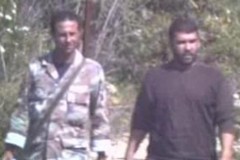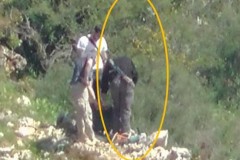What is UN Resolution 1701 & Why is it Important?
The international community, through the UN Security Council, has demanded multiple times that Hezbollah disarm. Instead, Hezbollah has continually ignored these demands. They ignored UN Resolution 1701, which called for a zone free of armed personnel besides the army of Lebanon. They ignored UN Resolution 1559 and the Lebanese Taif Agreement, which ended the Lebanese Civil War and called for the disbanding and disarmament of all Lebanese and non-Lebanese militias. Hezbollah clearly shows it has no intention of ever laying down its arms.
On January 28, Hezbollah fired five anti-tank missiles at a military vehicles near Mt. Dov in northern Israel, killing two soldiers and injuring seven others. Maj. Gen. Luciano Portolano, Head of Mission and Force Commander of the United Nations Interim Force in Lebanon (UNIFIL) strongly condemned the serious violation of Resolution 1701 of the Security Council.

![]()
United States Department of State spokeswoman Jen Psaki also condemned the Hezbollah attack and expressed support for Israel’s “legitimate right to self-defense.”
UN Resolution 1701
At the end of the Second Lebanon War in 2006, a ceasefire between the different parties was reached and the UN Security Council issued Resolution 1701. The resolution stated the following:
“[The Security Council] calls for Israel and Lebanon to support a permanent ceasefire and a long-term solution based on the following principles and elements:…the establishment between the Blue Line and the Litani river of an area free of any armed personnel, assets and weapons other than those of the Government of Lebanon.”
In clear violation of the resolution, Hezbollah has remained in southern Lebanon and has even expanded its missile arsenal. As of the summer of 2014, Hezbollah had an estimated 100,000 rockets and missiles with short, medium and long ranges, five times what it had during the Second Lebanon War.
Southern Lebanon remains Hezbollah’s terrorist stronghold. The organization is deeply rooted within the population, and Hezbollah flags can be seen near the border marking its presence in the area.The IDF regularly detects armed Hezbollah terrorists near the border, as recently as September 2014.
![]()

![]()

![]()



Section 8 of the resolution calls for the following principles:
“…full implementation of the relevant provisions of the Taif Accords, and of resolution 1559 (2004).”
Both UN Resolution 1559 and the Taif Agreement call for the “disbanding of all Lebanese and non-Lebanese militias,” including Hezbollah. Hezbollah never dismantled its military wing as these agreements required.
The Taif Agreement, signed in 1989, was designed to end the Lebanese Civil War. The major part of the agreement ordered all armed militias operating in Lebanon to disarm. Hezbollah did not, and a few years after the agreement was signed, Hezbollah was still firing hundreds of rockets on Israeli cities.
Two years after UN Resolution 1559 was adopted in 2004, Hezbollah, armed and trained, kidnapped three Israeli soldiers. Hezbollah’s actions forced Israel to initiate operational activity which developed into a war. During the course of the war, Hezbollah fired approximately 4,000 rockets into Israel and killed a total of 119 IDF soldiers and 44 Israeli civilians.
“…no foreign forces in Lebanon without the consent of its government.”
Hezbollah, despite the intent of the State of Lebanon, has not disarmed. “It is impossible for weapons to stay raised against the will of a democratic people and against the truth,” Saad al-Hariri, Former Prime Minister of Lebanon said on March 2013. “We want to put [Hezbollah’s weapons] under the control and authority of the state because it’s the army which protects us all.“
“…no sales or supply of arms and related materiel to Lebanon except as authorized by its Government.”
Weapons destined for Hezbollah, including rockets and missiles, are transferred from Iran into Lebanon by air, land, and sea and Syria plays a crucial role logistically. Hezbollah has various kinds of missiles, including both Iranian-manufactured rockets and Syrian-manufactured rockets.


Section 15 of the resolution goes on to state that:
“…all States shall take the necessary measures to prevent, by their nationals or from their territories or using their flag vessels or aircraft: (a) The sale or supply to any entity or individual in Lebanon of arms and related materiel of all types, including weapons and ammunition, military vehicles and equipment, paramilitary equipment, and spare parts for the aforementioned, whether or not originating in their territories…”
Syria and Iran freely sent arms to Hezbollah. UNIFIL troops (United Nations Interim Force in Lebanon) are designated as an observer force only. In 2006, former UN Secretary General Kofi Annan said, “Troops are not going in there to disarm – let’s be clear. The UNIFIL force will only carry out interception missions if asked by the Lebanese government.” Syria then declared that the deployment of any UN forces near its border would be considered a “hostile act,” making it hard for any force to prevent arms smuggling on a border that Syria refuses to let them monitor.


Since its creation, Hezbollah has used terror to achieve its goals: the destruction of Israel and the establishment of a Shia theocracy in Lebanon. They have disregarded all international calls to disarm. They continue to serve the interests of Iran. In return, the Iranians spare no effort in transferring missiles and rockets to their ally, the terrorist organization Hezbollah.

